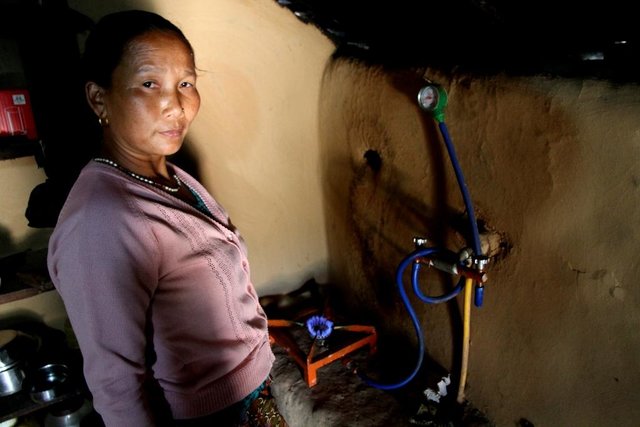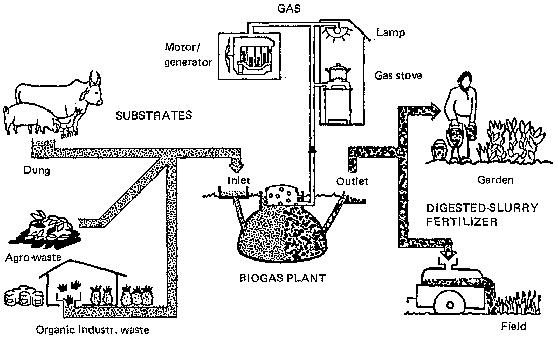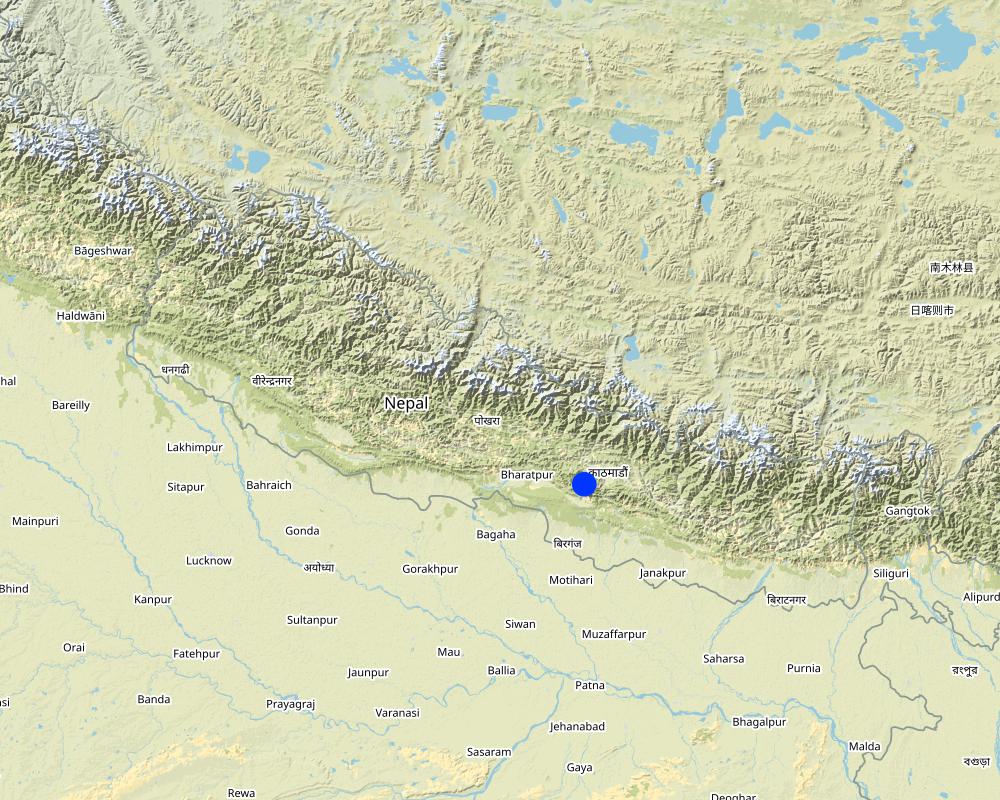Bio Gas [尼泊尔]
- 创建:
- 更新:
- 编制者: Sabita Aryal
- 编辑者: –
- 审查者: Alexandra Gavilano, David Streiff, Joana Eichenberger
Gobar gas (nepali)
technologies_1235 - 尼泊尔
查看章节
全部展开 全部收起1. 一般信息
1.2 参与该技术评估和文件编制的资源人员和机构的联系方式
SLM专业人员:
Pantha Samikshya
Kathmandu University
尼泊尔
SLM专业人员:
Giri Gyanu
Kathmandu University
尼泊尔
SLM专业人员:
Piya Shristi
Kathmandu University
尼泊尔
SLM专业人员:
Baidya Khatri Raghuram Ratna
Sarada Batase VDC
尼泊尔
有助于对技术进行记录/评估的机构名称(如相关)
Kathmandu University (KU) - 尼泊尔有助于对技术进行记录/评估的机构名称(如相关)
Sarada Batase Village Development Committee (Sarada Batase VDC) - 尼泊尔1.3 关于使用通过WOCAT记录的数据的条件
编制者和关键资源人员接受有关使用通过WOCAT记录数据的条件。:
是
1.4 所述技术的可持续性声明
这里所描述的技术在土地退化方面是否存在问题,导致无法被认为是一种可持续的土地管理技术?:
否
1.5 参考关于SLM方法(使用WOCAT记录的SLM方法)的调查问卷

Bio-gas [尼泊尔]
Production of fuel from the animal waste.
- 编制者: Sabita Aryal
2. SLM技术的说明
2.1 技术简介
技术定义:
Production of fuel and manure from animal waste
2.2 技术的详细说明
说明:
People here use animal as well as human waste for the production of biogas.Equal amount of dung and water is poured in the inlet and mixed by the help of mixture.Then the raw materials are passed to the digestor where gas (methane) is produced by an anerobic fermentation by methanogenic bacteria. The produced gas is collected in dome and slurry is drained out through an outlet.
Purpose of the Technology: The biogas produced from the plant is used as a fuel for cooking food. The bio gas produced can also be used to light bulbs.The slurry can be used as manure in agricultural fields.
Establishment / maintenance activities and inputs: About 24% houses is using this technique by the funds from international , national (government) and few by self funding . The digester should be cleaned every five years of its use.
Natural / human environment: Temperature maintenance is basic requirement for biogas production. (36 degree celsius).
It is most favorable if the plant is near the water resources and near to the fuel source i.e. cattle house.
2.3 技术照片
2.5 已应用该技术的、本评估所涵盖的国家/地区/地点
国家:
尼泊尔
区域/州/省:
Nepal
有关地点的进一步说明:
Kavre
具体说明该技术的分布:
- 均匀地分布在一个区域
如果不知道精确的区域,请注明大致覆盖的区域:
- > 10,000 平方千米
注释:
Boundary points of the Technology area: Altitude about 4900 feets
Map
×2.6 实施日期
如果不知道确切的年份,请说明大概的日期:
- 10-50年前
2.7 技术介绍
详细说明该技术是如何引入的:
- 在实验/研究期间
3. SLM技术的分类
3.1 该技术的主要目的
- 改良生产
3.2 应用该技术的当前土地利用类型

农田
- 一年一作
- 乔木与灌木的种植
年作 - 具体指明作物:
- 根/块茎作物 - 土豆
乔木和灌木种植 - 指定作物:
- 柑橘属
注释:
Major cash crop: Potatoes and oranges
Major land use problems (compiler’s opinion): Loss of fertile soil
Future (final) land use (after implementation of SLM Technology): Cropland: Ca: Annual cropping
3.4 供水
该技术所应用土地的供水:
- 混合雨水灌溉
3.5 该技术所属的SLM组
- 节能技术
3.6 包含该技术的可持续土地管理措施

农艺措施
- A7:其它
注释:
Type of agronomic measures: better crop cover, manure / compost / residues
3.7 该技术强调的主要土地退化类型

化学性土壤退化
- Cn:肥力下降和有机质含量下降(非侵蚀所致)
注释:
Main causes of degradation: deforestation / removal of natural vegetation (incl. forest fires), inputs and infrastructure: (roads, markets, distribution of water points, other, …)
Secondary causes of degradation: crop management (annual, perennial, tree/shrub), over-exploitation of vegetation for domestic use, overgrazing, change in temperature, change of seasonal rainfall, Heavy / extreme rainfall (intensity/amounts), wind storms / dust storms, floods, droughts, population pressure, land tenure, poverty / wealth, labour availability, governance / institutional
3.8 防止、减少或恢复土地退化
具体数量名该技术与土地退化有关的目标:
- 减少土地退化
4. 技术规范、实施活动、投入和成本
4.1 该技术的技术图纸
技术规范(与技术图纸相关):
First a pit is dug, perhaps ten feet deep. Then a water tight cement cylinder is constructed. Intake and outgo pipes are installed. The whole unit is made water tight. The manure is mixed with water in the intake basin to make slurry which then goes down the pipe to the digester. This whole cylinder is filled. Meanwhile, the whole mass bubbles methane up to the top. The gas builds the pressure and can be taken off through a rubber tube to a gas stove in the kitchen. When the cylinder is full the effluent comes out through the outer inlet, which is the byproduct of the plant and is the fertilizer for the field.
Location: Sarada Batase , VDC
Technical knowledge required for field staff / advisors: moderate
Technical knowledge required for land users: moderate
Main technical functions: stabilisation of soil (eg by tree roots against land slides)
Secondary technical functions: increase in organic matter, increase in nutrient availability (supply, recycling,…), spatial arrangement and diversification of land use
4.4 技术建立所需要的费用和投入
| 对投入进行具体说明 | 单位 | 数量 | 单位成本 | 每项投入的总成本 | 土地使用者承担的成本% | |
|---|---|---|---|---|---|---|
| 劳动力 | Labour | unit | 1.0 | 4500.0 | 4500.0 | |
| 设备 | Animal traction | unit | 1.0 | 5765.0 | 5765.0 | |
| 技术建立所需总成本 | 10265.0 | |||||
| 技术建立总成本,美元 | 10265.0 | |||||
4.5 维护/经常性活动
| 活动 | 时间/频率 | |
|---|---|---|
| 1. | Digestor cleaning | 5 years |
| 2. | Refilling the digestor | Daily |
4.7 影响成本的最重要因素
描述影响成本的最决定性因素:
1) Size of biogas plant
2) Materials required to build the plant
3) Labour Cost
5. 自然和人文环境
5.1 气候
农业气候带
- 半湿润
- 半干旱
Thermal climate class: tropics
5.2 地形
平均坡度:
- 水平(0-2%)
- 缓降(3-5%)
- 平缓(6-10%)
- 滚坡(11-15%)
- 崎岖(16-30%)
- 陡峭(31-60%)
- 非常陡峭(>60%)
地形:
- 高原/平原
- 山脊
- 山坡
- 山地斜坡
- 麓坡
- 谷底
垂直分布带:
- 0-100 m a.s.l.
- 101-500 m a.s.l.
- 501-1,000 m a.s.l.
- 1,001-1,500 m a.s.l.
- 1,501-2,000 m a.s.l.
- 2,001-2,500 m a.s.l.
- 2,501-3,000 m a.s.l.
- 3,001-4,000 m a.s.l.
- > 4,000 m a.s.l.
关于地形的注释和进一步规范:
Landforms: Also valley floors
5.3 土壤
平均土层深度:
- 非常浅(0-20厘米)
- 浅(21-50厘米)
- 中等深度(51-80厘米)
- 深(81-120厘米)
- 非常深(> 120厘米)
土壤质地(表土):
- 中粒(壤土、粉土)
如有可能,附上完整的土壤描述或具体说明可用的信息,例如土壤类型、土壤酸碱度、阳离子交换能力、氮、盐度等。:
Soil fertility is high - medium
Soil water storage capacity is high
5.4 水资源可用性和质量
地下水位表:
5-50米
地表水的可用性:
好
5.5 生物多样性
物种多样性:
- 中等
5.6 应用该技术的土地使用者的特征
生产系统的市场定位:
- 生计(自给)
- 商业/市场
非农收入:
- 收入的10-50%
相对财富水平:
- 贫瘠
个人或集体:
- 个人/家庭
机械化水平:
- 手工作业
- 机械化/电动
说明土地使用者的其他有关特征:
Population density: 100-200 persons/km2
Annual population growth: 1% - 2%
5.7 应用该技术的土地使用者使用的平均土地面积
- < 0.5 公顷
- 0.5-1 公顷
- 1-2 公顷
- 2-5公顷
- 5-15公顷
- 15-50公顷
- 50-100公顷
- 100-500公顷
- 500-1,000公顷
- 1,000-10,000公顷
- > 10,000公顷
这被认为是小规模、中规模还是大规模的(参照当地实际情况)?:
- 小规模的
5.8 土地所有权、土地使用权和水使用权
土地所有权:
- 社区/村庄
土地使用权:
- 个人
5.9 进入服务和基础设施的通道
健康:
- 贫瘠
- 适度的
- 好
教育:
- 贫瘠
- 适度的
- 好
技术援助:
- 贫瘠
- 适度的
- 好
就业(例如非农):
- 贫瘠
- 适度的
- 好
市场:
- 贫瘠
- 适度的
- 好
能源:
- 贫瘠
- 适度的
- 好
道路和交通:
- 贫瘠
- 适度的
- 好
饮用水和卫生设施:
- 贫瘠
- 适度的
- 好
金融服务:
- 贫瘠
- 适度的
- 好
6. 影响和结论性说明
6.1 该技术的现场影响
社会经济效应
生产
作物生产
木材生产
生产区域
能源生产
收入和成本
农业投入费用
农业收入
工作量
注释/具体说明:
No need to collect wood
社会文化影响
食品安全/自给自足
健康状况
livelihood and human well-being
注释/具体说明:
With the help of this technology the living standard of rural women and men has been improved. It has increased the employment as well as productivity. It has also reduce dependency on traditional energy and attain sustainable development via integrating the alternative energy with the socio-economic activities of women and men in rural communities.
生态影响
水循环/径流
地表径流
土壤
土壤水分
养分循环/补给
土壤有机物/地下C
生物多样性:植被、动物
生物量/地上C
害虫/疾病控制
减少气候和灾害风险
碳和温室气体的排放
6.2 该技术的场外影响已经显现
地下水/河流污染
对邻近农田的破坏
6.3 技术对渐变气候以及与气候相关的极端情况/灾害的暴露和敏感性(土地使用者认为的极端情况/灾害)
渐变气候
渐变气候
| 季节 | 增加或减少 | 该技术是如何应对的? | |
|---|---|---|---|
| 年温度 | 增加 | 不好 |
气候有关的极端情况(灾害)
气象灾害
| 该技术是如何应对的? | |
|---|---|
| 局地暴雨 | 不好 |
| 局地风暴 | 好 |
气候灾害
| 该技术是如何应对的? | |
|---|---|
| 干旱 | 不好 |
水文灾害
| 该技术是如何应对的? | |
|---|---|
| 比较和缓的(河道)洪水 | 不好 |
6.4 成本效益分析
技术收益与技术建立成本相比如何(从土地使用者的角度看)?
短期回报:
稍微积极
长期回报:
积极
技术收益与技术维护成本/经常性成本相比如何(从土地使用者的角度看)?
短期回报:
积极
长期回报:
中性/平衡
6.5 技术采用
注释:
There is a little trend towards spontaneous adoption of the Technology
6.7 该技术的优点/长处/机会
| 土地使用者眼中的长处/优势/机会 |
|---|
| used as a fertilizer |
| Efficient cooking method. |
| 编制者或其他关键资源人员认为的长处/优势/机会 |
|---|
| Decreases the dependency on wood. |
| Reduces health problems due to air pollution. |
| Improves the living standard of rural men and women. |
| Use of alternative energy resources. |
6.8 技术的弱点/缺点/风险及其克服方法
| 土地使用者认为的弱点/缺点/风险 | 如何克服它们? |
|---|---|
| Size of digestion is too big due to which its requirement cannot be fulfilled. | Size should be maintained according to the available resources. |
| 编制者或其他关键资源人员认为的弱点/缺点/风险 | 如何克服它们? |
|---|---|
| If methane produced is leaked in atmosphere can sustain global warming. | Should be well constructed. |
| leakage from the plant may be mixed in the water sources. | Prevent leakage with timely maintainance. |
7. 参考和链接
7.1 信息的方法/来源
- 实地考察、实地调查
- 与土地使用者的访谈
(现场)数据是什么时候汇编的?:
07/01/2015
链接和模块
全部展开 全部收起链接

Bio-gas [尼泊尔]
Production of fuel from the animal waste.
- 编制者: Sabita Aryal
模块
无模块





